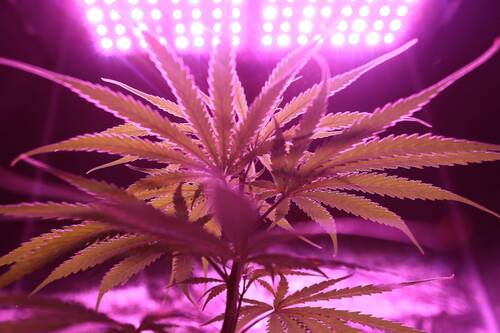[[{“value”:”
20 May How New Technologies Might Impact the Medical Marijuana Industry
Posted at 12:55h
in Cannabis
by
Editor’s note:Discuss your use of Cannabis or CBD products with your health care provider. Dosing of CBD is variable, especially since it is not FDA regulated. Cannabis/CBD may interfere with other medications and should not be used in individuals with certain health conditions, including liver issues. CBD skin care products can be absorbed through the skin and have similar effects. Do not use Cannabis products including edibles and CBD if you are pregnant, nursing or may become pregnant. Do not use cannabis products if driving or operating difficult or dangerous machinery. Children should not be exposed to cannabis or CBD products.
The medical marijuana industry is growing quickly, thanks to new technology. These advancements are improving how cannabis is grown, how patients access it, and how products are made.
As more states expand their medical marijuana programs, technology is making it easier for patients to get high-quality medical cannabis in a safe and reliable way. See how new tech impacts medical marijuana at TeleLeaf.
Better Ways to Grow Medical Marijuana
Growing medical marijuana requires careful control of light, water, and nutrients to produce high-quality plants. New technology is helping growers produce consistent, high-quality medical cannabis while using fewer resources.
● Precision Growing
Growers are now using smart sensors to monitor the environment in real time. These devices track temperature, humidity, and nutrient levels to make sure each plant gets exactly what it needs to grow properly. This also helps improve the quality and potency of medical cannabis.
● Vertical Farming
Instead of growing cannabis on large outdoor farms, many companies are turning to vertical farming—stacking plants in layers inside buildings. This saves space and allows for year-round production in controlled environments. With advanced lighting and climate control, growers can produce consistent, high-quality cannabis regardless of the weather.
● Automation in Cultivation
Technology is making the growing process more efficient. Automated watering and feeding systems reduce human error and make sure each plant gets the right amount of nutrients. This leads to healthier plants and a more reliable supply for patients.
New and Improved Medical Marijuana Products
Technology is also making medical marijuana easier to use. Patients have more choices beyond traditional flower, including oils, tinctures, edibles, and patches. These advancements help patients find a method that works best for their condition.
Better Extraction Methods
Companies use advanced extraction techniques, like CO₂ extraction, to separate cannabinoids from the plant. This creates precise and consistent products like oils and tinctures.
Some companies are also using nanoencapsulation, which makes cannabinoids easier for the body to absorb. It also means faster and more predictable effects.
More Consumption Options
Patients now have access to medical marijuana in different forms, including:
Tinctures – Liquid extracts that can be placed under the tongue for quick absorption.
Edibles – Cannabis-infused food and drinks for a slower, longer-lasting effect.
Transdermal Patches – Slow-release patches that deliver cannabinoids over time.
Capsules and Tablets – Easy-to-dose forms that work like traditional medicine.
These options help patients choose the best method for their needs while making it easier to control their dosage.
Technology is Making Medical Marijuana More Accessible
Getting medical marijuana can be a challenge for many patients. New technology is making the process easier, especially for those who can’t visit a doctor in person.
Telemedicine Consultations
Many states allow patients to get a doctor’s recommendation through telemedicine. You can talk to a doctor over the phone or video call instead of going to an in-person appointment. Telemedicine makes it easier for patients in remote areas or those with mobility issues to access medical marijuana.
Online Ordering and Delivery
Some states allow patients to order medical marijuana online and have it delivered to their homes. This is especially helpful for patients who have trouble visiting a dispensary. Online platforms also let patients compare products and read reviews before making a choice.
Educational Tools
Technology is helping patients learn more about medical marijuana. Websites, apps, and online communities provide information about different cannabis strains, how they work, and what conditions they might help with. This allows patients to make informed decisions about their treatment.
Improving Safety and Quality Control
Ensuring the safety of medical marijuana is important. New technology is helping the industry maintain high standards and protect patients.
Lab Testing for Purity and Potency
Before medical marijuana reaches patients, it goes through lab testing to check for pesticides, mold, and other harmful substances.
Advanced testing equipment can detect even tiny amounts of unwanted chemicals, making sure the final product is safe. Testing also helps ensure accurate labeling, so patients know exactly how much THC, CBD, and other cannabinoids are in their medicine.
Seed-to-Sale Tracking
Many states require medical marijuana to be tracked from the moment it is planted until it is sold. This seed-to-sale tracking system helps prevent illegal sales and ensures patients receive safe, high-quality products. Companies use barcodes, QR codes, and blockchain technology to keep records of each plant’s journey.
Blockchain for Transparency
Blockchain technology is being used to create secure, unchangeable records of transactions. This helps prevent fraud, ensures product authenticity, and builds trust in the medical marijuana supply chain.
How Data is Helping Patients Get the Best Results
Technology is also helping doctors and researchers understand how medical marijuana works. Researchers can learn which strains, doses, and delivery methods work best for different conditions by analyzing data from patients
Big Data and Personalized Medicine
With more patients using medical marijuana, companies are collecting data on how different products affect people.
This data helps improve recommendations, allowing patients to find the best strain and dosage for their needs. In the future, patients may even receive personalized medical marijuana treatments based on their unique body chemistry.
Ongoing Research into Cannabis Compounds
THC and CBD are the most well-known cannabinoids, but cannabis contains many other compounds that might have medical benefits.
Researchers are studying terpenes and minor cannabinoids to see how they contribute to the effects of medical marijuana. This could lead to the development of new products designed for specific conditions.
Sustainable and Eco-Friendly Innovations
As demand for medical marijuana grows, companies are looking for ways to produce cannabis sustainably. New technology is helping the industry reduce waste and lower its environmental impact.
Energy-Efficient Grow Facilities
Indoor cannabis cultivation requires a lot of electricity. New LED lighting systems and climate control technologies are helping reduce energy use while maintaining high-quality growing conditions.
Water-Saving Techniques
Advanced irrigation systems monitor soil moisture and deliver just the right amount of water to plants. This prevents waste and helps conserve resources, especially in areas where water is scarce.
Reducing Cannabis Waste
Technology is also helping companies find ways to use cannabis plant waste. Some businesses are turning leftover plant material into biofuels, compost, or other useful products.
The Future of Medical Marijuana Technology
New technology is making medical marijuana safer, easier to access, and more effective. As more states expand their medical marijuana programs, technology will continue to play an important role in improving patient care.
From better growing techniques and safer products to telemedicine and personalized treatments, these advancements are helping more patients benefit from medical marijuana. As research continues and technology advances, the future of medical cannabis looks bright.
—-
More information:
Reference: Sarma ND, et al. Cannabis Inflorescence for Medical Purposes: USP Considerations for Quality Attributes. Journal of Natural Products. 2020.
https://pubs.acs.org/doi/10.1021/acs.jnatprod.9b01200
Reference: Medical Cannabis Frequently Asked Questions for Patients. Washington State Department of Health. 2024
https://doh.wa.gov/you-and-your-family/cannabis/medical-cannabis/patient-information/frequently-asked-questions
—-
The information on MedicalResearch.com is provided for educational purposes only, and is in no way intended to diagnose, cure, or treat any medical or other condition. Some links are sponsored. Products are not warranted or endorsed.
Always seek the advice of your physician or other qualified health and ask your doctor any questions you may have regarding a medical condition. In addition to all other limitations and disclaimers in this agreement, service provider and its third party providers disclaim any liability or loss in connection with the content provided on this website.
2
“}]] As demand for medical marijuana grows, companies are looking for ways to produce cannabis sustainably. New technology is helping the industry reduce waste and lower its environmental impact. Read More


